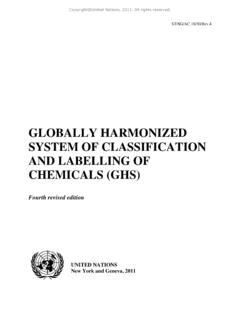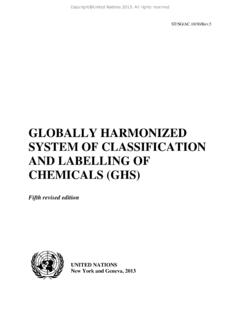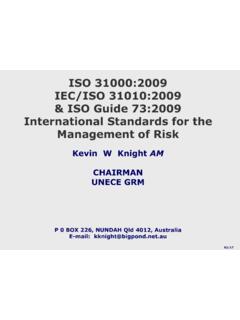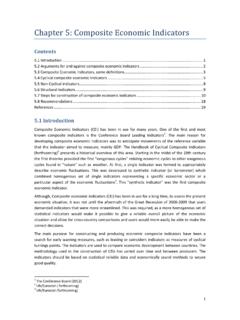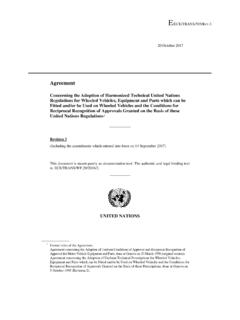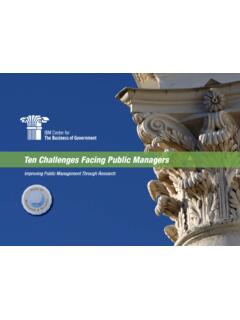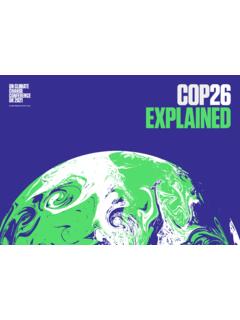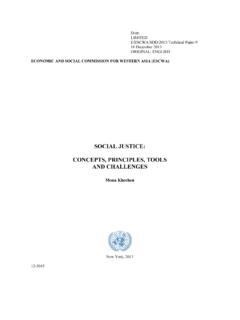Transcription of Shared Socioeconomic Pathways (SSPs) - UNECE
1 1 Shared Socioeconomic Pathways (SSPs) Global climate change studies rely on numerous assumptions and factors related to policy options and societal developments. Shared Socioeconomic Pathways (SSPs) were developed over the last years as a joint community effort (by an international team of climate scientists, economists and energy systems modelers) to provide a toolkit for the climate change research community to carry out integrated, multi-disciplinary analysis. They describe plausible major global developments that together would lead in the future to different challenges for mitigation and adaptation to climate change. They have also been described as stories that happened in the future (Armstrong & Green, 2012), aiming to explore how the future can evolve under a consistent set of assumptions.
2 The SSPs are based on five narratives describing alternative socio-economic developments, including sustainable development, regional rivalry, inequality, fossil-fueled development, and middle-of-the-road development (Riahi et al., 2017). In the context of the Pathways to Sustainable Energy project, SSP2 (or else the so-called Middle of the Road scenario) was set as the Reference scenario. The following figure illustrates the drivers under the different SSPs and how the SSP2 stands for the middle of the road scenario. SSP Storylines A summary of the SSP2 storyline (quoted from relevant references) is provided here for comprehensiveness.
3 For further details and extended descriptions of SSP storylines, please refer to (O Neill et al.,2014; 2015), while more focused documentation on SSP2 can be found in (Fricko et al., 2016). You can also find below key assumptions on SSP2 quantitative elements (in terms of Energy, Agriculture & Land Use). SSP 2 - Middle of the Road (or Dynamics as Usual, or Current Trends Continue, or Continuation, or Muddling Through): The world follows a path in which social, economic, and technological trends do not shift markedly from historical patterns. Development and income growth proceed unevenly, with some countries making relatively good progress while others fall short of expectations.
4 Most economies are politically stable. Globally connected markets function imperfectly. Global and national institutions work toward but make slow progress in achieving sustainable development goals, including improved living conditions and access to education, safe water, and health care. Technological development proceeds apace, but without fundamental breakthroughs. Environmental systems experience degradation, although there are some improvements and overall the intensity of resource and energy use declines. Even though fossil fuel dependency decreases slowly, there is no reluctance to use unconventional fossil resources. Global population growth is moderate and levels off in the second half of the century as a consequence 2 of completion of the demographic transition.
5 However, education investments are not high enough to accelerate the transition to low fertility rates in low-income countries and to rapidly slow population growth. This growth, along with income inequality that persists or improves only slowly, continuing societal stratification, and limited social cohesion, maintain challenges to reducing vulnerability to societal and environmental changes and constrain significant advances in sustainable development. These moderate development trends leave the world, on average, facing moderate challenges to mitigation and adaptation, but with significant heterogeneities across and within countries.
6 (O Neill et al., 2015) SSP2 does not imply a simple extrapolation of recent experience, but rather a development pathway that is consistent with typical patterns of historical experience observed over the past century . For example, emerging economies grow relatively quickly and then slow as incomes reach higher levels, the demographic transition occurs at average rates as societies develop, and technological progress continues without major slowdowns or accelerations. Thus, it is a dynamic pathway, yet one in which future changes in various elements of the narrative are consistent with middle of the road expectations, rather than falling near the upper or lower bounds of possible outcomes.
7 There are likely many reasons that trends in SSP elements could end up being moderate, and no specific stance is taken here as to motivating forces. Population and economic development Population and economic developments have strong implications for the anticipated mitigation and adaptation challenges . For example, a larger, poorer population will have more difficulties to adapt to the detrimental effects of climate change. Understanding how population and economic growth develops in the SSPs therefore already gives a first layer of understanding of the multiple challenges . Population growth evolves in response to how the fertility, mortality, migration, and education of various social strata are assumed to change over time.
8 In SSP2, global population steadily grows to billion people around 2070, and slowly declines thereafter (KC and Lutz, 2015). Gross Domestic Product (GDP) follows regional historical trends (Dellink et al., 2015). With global average income reaching about 60 (thousand year-2005 USD/capita, purchasing-power-parity PPP, , GDP/capita) by the end of the century , SSP2 sees an increase of global average income by a factor 6. The SSP2 GDP projection is thus situated in-between the estimates for SSP1 and SSP3, which reach 2100 global average income levels of 82 and 22 (thousand year-2005 USD/capita PPP), respectively. SSP2 depicts a future of global progress where developing countries achieve significant economic growth.
9 Today, average per capita income in the global North is about five times higher than in the global South. In SSP2, developing countries reach today s average income levels of the OECD by around 2060 2090, depending on the region. However, modest improvements of educational attainment levels result in declines in education-specific fertility rates, leading to incomplete economic convergence across different world regions. This is particularly an issue for Africa. Overall, both the population and GDP developments in SSP2 are designed to be situated in the middle of the road between SSP1 and SSP3, see KC and Lutz (2015) and Dellink et al. (2015) for details.
10 (Fricko et al., 2016). 3 SSP1, 2 and 3 Assumptions on quantitative elements (Source: Fricko et al., 2016) * All indicators apply to 2010 2100; Intensity improvements are in FE/GDP annually. 4 References Armstrong, , Green, , 2012. Forecasting Dictionary. The Wharton School, University of Pennsylvania. Dellink, R., Chateau, J., Lanzi, E., Magn , B., 2015. Long-term economic growth projections in the Shared Socioeconomic Pathways . Global Environ. Change 42, 200-214. Fricko et al., 2016. The marker quantification of the Shared Socioeconomic Pathway 2: A middle-of-the-road scenario for the 21st century . Global Environmental Change 42, 251-267. KC, S., Lutz, W., 2015.


